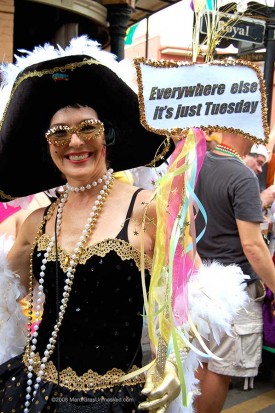If you think it’s all about booze, beads and Girls Gone Wild revelry, then it’s time for Mardi Gras 101 — a core requirement for those aspiring to comprehend the origins, evolution and cultural significance of a storied civic ritual with innumerable facets and traditions.
Getting up to speed on Mardi Gras essentials
Fat Tuesday masker
A time for merriment and make-believe, for mirthful mockery and the creative indulgence of whimsy.
There’s more to Mardi Gras than fancy parties, glitzy parades and bawdy revels on Bourbon Street. Indeed, because the celebration is so multifaceted and encompasses so much tradition and history — the first newspaper account of an organized Mardi Gras parade in New Orleans appeared in 1837 — and because it’s so tightly interwoven into the peculiar racial and social fabric of the city, it can be a challenge to get one’s arms around what it’s all about.
Since having been transplanted from Europe during the colonial era, Carnival — the season of merriment and make-believe that begins on feast of the Epiphany (January 6) and ends on Mardi Gras (Fat Tuesday) — has evolved from a local celebration for residents into an iconic, internationally recognized spectacle that encompasses and expresses all that New Orleans essentially is.
Contrary to media stereotypes, Mardi Gras is not about mass inebriation and immodest exhibitionism. It’s about creative costuming and krewes staging processions that are a feast for the senses, with floats that bemuse and entertain, bands full of joyful noise, inspired dance troupes and showers of baubles that stoke an exhilarating feeding frenzy.
Reveling around the fringes of the mainstream is a multitude of smaller-scale processions that are not part of the official parade schedule. For information about these and other happenings that animate the cultural extravaganza that is Mardi Gras in New Orleans, check out our Calendar. There you can easily sort events by genre and conveniently share listings via Twitter, social networking sites or e-mail.
Marie Antoinette float in the 2011 ‘tit Rex parade
This procession of handcrafted miniature floats, which rolls through the Bywater neighborhood on the second Saturday before Mardi Gras, is one of many offbeat expressions of indigenous culture that can be found away from the city’s main parade thoroughfare.
Photo ©Pat Jolly
The last thirty years or so have witnessed a huge expansion in the annual number or parades, media coverage, tourist interest and money spent in connection with the festivities. Consequently, as sociologist Kevin Fox Gotham has observed, the Mardi Gras “experience” has become more accessible to outsiders and, in the process, increasingly associated with mass entertainment and consumer culture. The panorama of its bounty is truly immense, encompassing virtually every art form, and it can take years of crisscrossing the city during Carnival to glimpse first-hand the full panoply of rituals and activities on offer.
For New Orleanians, despite national media fascination with the more risqué side of the revelry, the gala has retained much of its traditional family orientation — not so surprising considering that the children of the realm have a ton of fun at Mardi Gras. The enduring popularity of the Mardi Gras tradition has a lot to do with its playful, frolicsome associations summoning the lost innocence of youth.
Ready to bone up on the trappings and traditions, the cultural significance and storied pageantry of The Greatest Free Show on Earth? Start by delving into some historical background and terminology, then test your Carnival knowledge with our interactive Trivia Challenge: Virgin, Intermediate, Advanced and (for those qualified to earn a doctoral degree in the minutiae of Mardi Gras) Junkie levels.
If you’re contemplating a trip to New Orleans in the early part of the year, mark the date of Mardi Gras. And if you’re going to be in town for the festivities, be sure to get hip to Mardi Gras Tips & Tricks.
MardiGrasTraditions.com


